Khao Yai National Park: On the trail of wild elephants
A national park located about 3 hours northwest of Bangkok, Khao Yai was the first of its kind to be created, in 1962. Today it is the 3rd largest national park in Thailand and is home to a large number of wild animals including wild elephants, which are often the primary reason for a visit to this magnificent mountainous area.
About the national park
The park covers an area of 2 km², straddling the provinces of Nakhon Nayok and Nakhon Ratchasima (Khorat) mainly, but also that of Prachinburi to the east of the mountain.
Khao Yai encompasses areas of rainforest/evergreen forest, grassland and dry coniferous forest. With an elevation of 1 meters, Mount Khao Rom is the highest mountain in the national park. The average elevation of the national park ranges from 351 to 400 meters.
Khao Yai is part of the Dong Phayayen-Khao Yai Forest Complex, a UNESCO World Heritage Site, covering 5 protected areas from Khao Yai to the Cambodian border. In fact, in this entire area, besides Khao Yai, there are no less than 4 other national parks and protected areas (Pang Sida National Park, Thap Lan National Park, Ta Phraya National Park and Dong Yai Wildlife Sanctuary).
Khao Yai National Park Maps
Here are 2 maps to help you locate the national park in relation to Bangkok and another showing the network of roads and hiking trails inside the park.
Getting to Khao Yai National Park
Obviously the easiest and as usual, I recommend going there independently, renting a car from Bangkok either alone or with a driver. Knowing that the park is easy to access and the main road crossing the park is in good condition.
Inside the park, the speed is limited to 60 km/h to avoid the surprise of seeing a wild animal suddenly cross and crush it... Which unfortunately happens, because it is not always respected, given the beautiful straight lines that there are sometimes...
From Bangkok
– By minivan: There are minivans departing from the Mo Chot bus terminal north of Bangkok. These go to Pak Chong, the small town north of the park which mainly serves as a base for the national park.
– By bus: there are regular buses (every half hour) also leaving from Mo Chit. Their terminus will however generally not be Pak Chong but more likely Nakhon Ratchasima, make sure that the bus you take stops at Pak Chong. Allow 180 Baht for this journey of about 2h30.
– By train: a train line connecting Bangkok to Ubon Ratchathani passes through Pak Chong. However, it is neither the fastest nor the most economical, because with a seat at 186 Bahts in 3rd class and 292 Bahts in 2nd, for a journey of at least 3 hours, you really have to like the experience and have the time. Note that this train also passes through Ayutthaya.
– By taxi: it is also possible to find taxis which you can either use for the trip to Pak Chong, in this case, count 2300 Baht, but it is more interesting to rent it for the day and use it to also visit the national park, in which case, count around 3500 Baht for the day.
From Pak Chong
Once you are in Pak Chong, you will find songthaews (the common pick-up taxis as a reminder) from 8am until 16:30pm. Big downside however, if these will take you to the park, they do not go IN it and will therefore drop you off at the north entrance.
So there are still 14 km to reach the Visitor Center, the central point of the park. So what about getting there, knowing that walking is forbidden, the only possibility would be to get a lift from the entrance point.
Scooters can be found for rent in Pak Chong, and also at the park entrance at Sankhao Yai Guesthouse (located just before the northern entrance). Expect to pay 300 Baht for the first, 600 Baht for the second.
If my first visit to the national park was on 2 wheels, I would like to remind you to be careful, especially on a mountain road with wild animals likely to cross at any time (for example, there are monkeys at the beginning of the northern area, before the first viewpoint)
I can also only remind you to be in good standing, that is to say international license in your pocket AND French motorcycle license (the exception of driving 125cc does not work here!), see all the information on the article dedicated to driving in thailand.
From Ayutthaya
As I mentioned above, there is a train connecting Ayutthaya to Pak Chong. Basically, a train every 2-3 hours for a journey of about 2 hours. This is much cheaper since it should not exceed 100 Baht (83 Baht in 2nd class).
Animals in Khao Yai
As indicated in the title, and also mentioned in the intro, the national park contains a rich fauna including wild elephants, which it is possible to come across during a visit to the park.
A little aside for a warning. A wild elephant has nothing to do in terms of behavior with the elephants of the sanctuaries which are domesticated. Do not try to approach them under any circumstances!!
If you come across them in your car, keep the engine running and be ready to turn around as soon as the beast gets too close. Here is a video that sums up very well (in English), how to react when faced with such an encounter:
But if the elephants are a bit of the "stars", you can easily come across monkeys (macaque, but also gibbon, which you can often hear screaming in the distance in the forest), and if you are observant, exotic birds like hornbills (or bucerotidae), you will find the largest concentration of them in all of Thailand.
Easy too, they are deer and does, which tend to stay in the parking lot of the visitor center in particular. I also came across wild pigs there as well as a porcupine gently crossing the parking lot. In the possible walk around the visitor center, I was already able to see a snake.
There, I have just listed what is most likely to be encountered. Because otherwise, we could also come across Asian black bears (smaller than their brown cousin), otters, gaurs (also called gayal, the largest bovine existing on earth), dholes (also called cuon or Asian wild dog, it is more telling) and even jackals.
And that's for the mammal part. I'm not mentioning the tiger, because if there are any in the region, they are more in the Thap Lan area and the Pang Sida National Park, which is next to Khao Yai, but geographically, it's not the same place so I'm staying consistent.
Among the birds, there are more than 300 species, resident or migratory. There are exotic birds such as the "bearded ones" (from the toucan family), minivets, pittas (a type of passerine), but also more down-to-earth birds such as partridges or pheasants.
If you like reptiles (or not), there are also snakes like reticulated pythons, green ratters or even ptyas korros (not easy to pronounce...). You can come across lizards like the "classic" monitor lizards (even in Bangkok, there are some, that's why I say "classic") but also green water dragons or Chinese water dragons, colorful lizards reminiscent of iguanas on a smaller scale.
After that it is an exception since he would be alone, he drags a Siamese crocodile there, yes, only ONE (Despite that, a French woman managed the feat of not only finding it, but wanting to take a selfie with it, with the result of having her leg bitten... True since we find the information here)
Accommodations around Khao Yai
Before getting into the heart of the matter on what there is to see, let's see what are the accommodation options around and in the park. Because if it is possible to make a day visit from Bangkok, it remains interesting if not recommended, to stay a night in the surroundings to better enjoy the places.
Accommodation in Pak Chong
Generally, the town of Pak Chong, located to the north of the national park, serves as the main base. To the south of the park, you have the town of Nakhon Nayok which is still a possibility but less popular (the fact is that most of the accommodation options in this area are out of the way rather than in town. Indeed, you will have quite a few resorts closer to the waterfalls of Wang Ta Krai and Nang Rong, both located near the Khun Dan Prakarn Chon dam, at the foot of the mountain).
The first time I came, I was sleeping in Pak Chong. As we were out with a friend, we were originally planning to sleep in the park, but since we had been hanging around on the way, it was better for us not to go into the park in the middle of the afternoon.
Tharakiree Place Hotel
A perfectly decent, basic hotel, located near a supermarket, just off the main road. Add to that a reasonable rate, it made for a convenient stopover option, just outside the town of Pak Chong.
Learn more and book Tharakiree Place Hotel
If you have a tighter budget, there is the Hello Hostel Pakchong which offers good value for money (less than €20 per night).
For even smaller budgets, and known for providing interesting treks and tours in the park, you can stay at Greenleaf Guesthouse, for only 300 Baht per night.
If you are looking for something more cozy, you have the excellent Isaree Secret Garden, for €60. A little out of the way from Pak Chong so it's better to have a car, but if you like places with a certain charm and a more "traditional" look, then this is for you!
Otherwise, you can always search to find what you are looking for:
At the foot of the mountain
The next time I went to Khao Yai again, I rested at the foot of the mountain. In this case, I arrived from the south of the park (via Nakhon Nayok), and after having visited the park partly during the day. Wanting to complete my visit with a 2nd day and not having planned to camp, it was just on the way out to the north of the park, rather than returning to Pak Chong, that I decided to put down my suitcases.
There are many resorts there, many of which have themes specific to the region, such as "farm" or Tuscan-style estates, etc. The one I chose had a certain class, was brand new, with a swimming pool. In concrete terms, sleeping there compared to Pak Chong is 20 km less.
Best Way Resort
Budget: from 1650 Baht (45€)
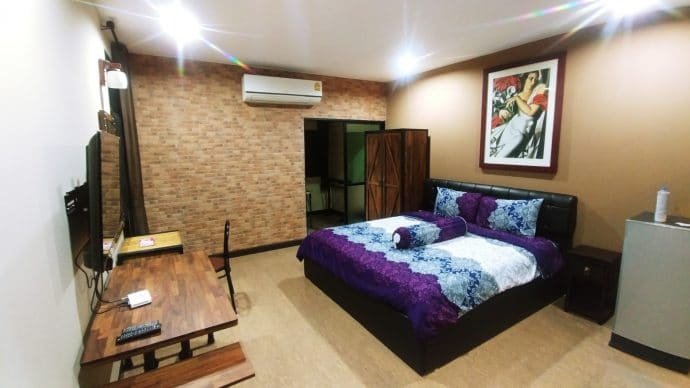
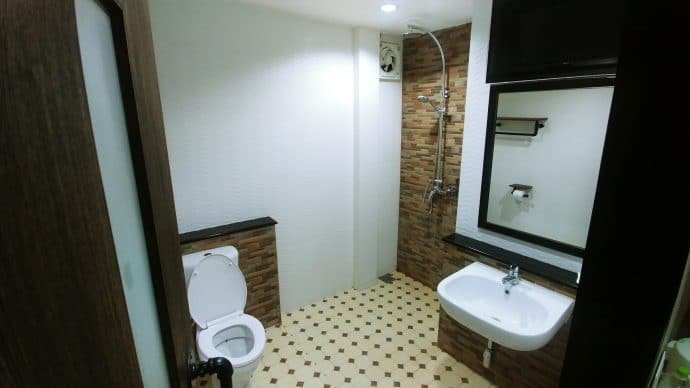
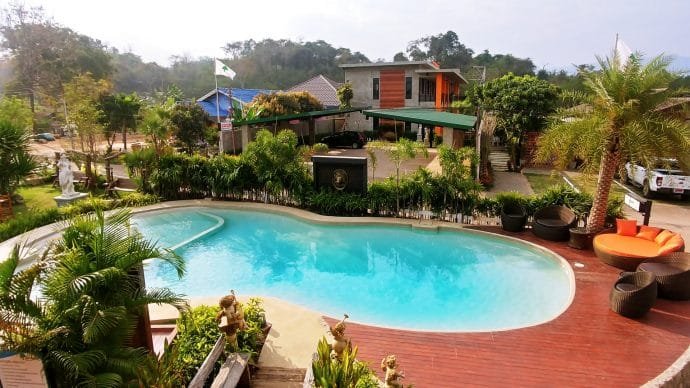
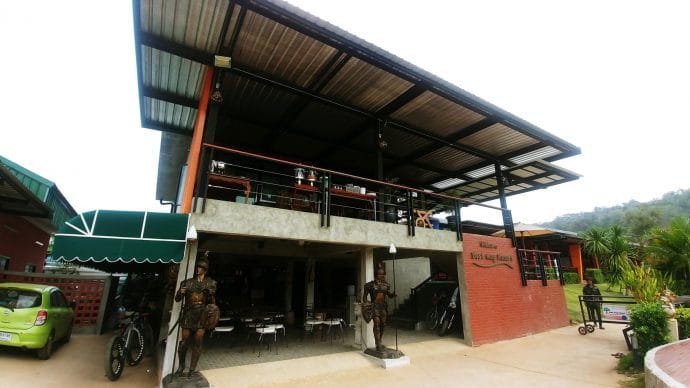
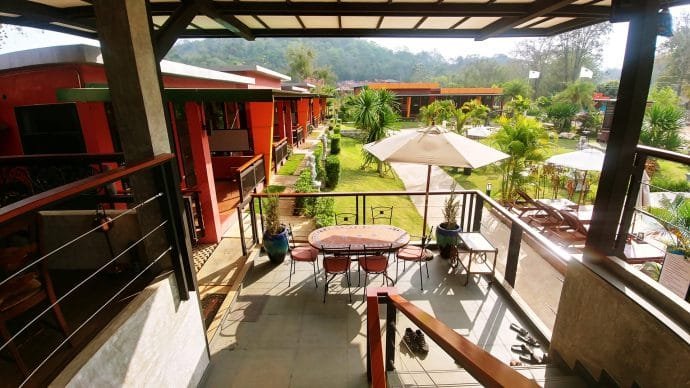
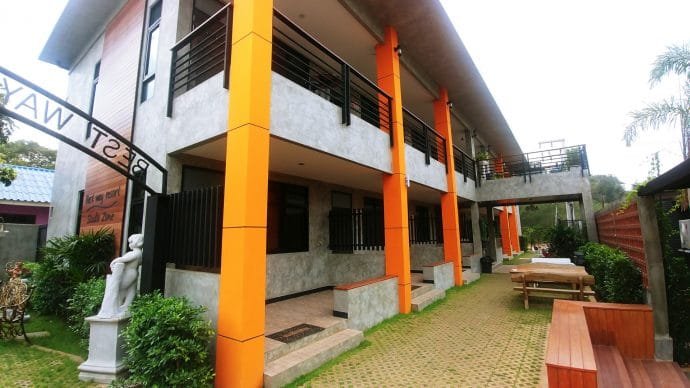
For a good price, you will have a large comfortable room of 32 m². The hotel is in 2 parts, one having the building serving as reception where breakfast is served (included in the price), in front is the swimming pool and on the side some rooms. The other part includes other rooms, where I stayed and private villas with their small swimming pool.
Learn more and book the Best Way Resort
For a lower budget and if the swimming pool is not essential, you have in the same place just behind, The Frog Khao Yai Resort (from 1250 Baht, or €35), which also has family rooms for 4 (for €70, breakfast included)
Sleeping in the park
The other obvious option is to simply sleep in the park itself. If you plan on doing the visit over 2 days, it's still the most practical to stay on site, rather than having to go through security again and make a quick return trip out of the park.
Having tried it twice, it is unfortunately not possible to take a room on site. If you want to sleep in a bungalow, you must book in advance via the official website of the DNP (Department of National Park, which manages national parks and nature reserves in Thailand).
Note that you cannot book more than 60 days in advance. You can choose from different areas, the Visitor Center, the main one, corresponding to zone 1. The rooms are generally for 2 or 3 people, but there are also some that can accommodate up to 6 people. Big downside, most are 2 Baht (400 €, given the standing, it is really not cheap). Some rooms are 67 Baht in zone 800 (shortly after an observation area, where the Mo Sing observation tower is located).
For clarity, here is a summary of how to proceed with the reservation:
Visit the official DNP website
If you are more of a last minute type and do not want to book in advance, there is still the camping option. There are 2 camps on the road to Haew Suwat Waterfall (Lam Takong and Pha Kluai Mai Camp Site) where you can rent equipment if you do not have equipment.
Each camp has toilets, showers, parking spaces. Tents are available for rent from 250 Baht (2 persons), accessories such as sleeping bags, pillows, blankets etc for 20-50 THB each. The area around both campsites is ideal for hiking.
Be careful though, monkeys often roam around looking for food. Don't leave anything in your tents and it is advisable to leave them open, otherwise the monkeys will tear everything up to force their way in.
When to visit the park?
Just like the rest of the country, there are 3 seasons:
The rainy season : May to October – You will have high humidity, average temperatures of 27 degrees during the day and 13 degrees at night, it is the perfect season to see waterfalls and a lush forest (as a reminder, the rainy season is not insurmountable and rains constantly!).
The cold season (also called “winter” here) : November to February – it’s clear and sunny skies. Average temperatures around 22 degrees during the day and up to 9-10 degrees at night (so if you’re sleeping in a tent, bring something warm).
The hot season : March to April. Humid heat with daily temperatures ranging from 20-30 degrees or more during the day and 17 degrees at night. As this season follows winter, which also marks the long period without rain before the return of the monsoon, nature is a bit deteriorating, viewpoints are blocked by heat haze and waterfalls are reduced, not the ideal season in short.
What to see in Khao Yai Park
Let's get (finally!) to the heart of the matter, what is there to see in this park, apart from the possible elephants to come across and the mountains? A start of an answer, quite a few waterfalls! First, you will have to pass the checkpoint to enter the park, to the north or to the south.
Starting from a northern entrance, the most classic, you will begin the ascent by passing immediately after the Chao Por Khao Yai sanctuary, an altar dedicated to the "spirit" of Khao Yai. It is an almost obligatory stop for the Thais who come to pray in order to show their respect and ask for protection.
Shortly after, you should come across your first animals, monkeys are often seen on the road climbing towards the Visitor Center, located 15 km from the northern checkpoint.
Visitor Center
This is the nerve center of the national park. You will find places to eat, places to sleep and it is also the best place to get information. In the main building, in addition to information panels on the fauna and flora of Khao Yai, you can get information on hikes and maps at the counter.
This is also where you can call on a park guide to accompany you on a hike, to better observe the animals and to insert yourself deeper into the Khao Yai forest. Note that a guide is mandatory for all hikes, except 2 short walks accessible to all.
One of them is possible from the Visitor Center. Right next to the main building next to the parking lot (just after a small bridge). This walk is short since it is only 800m. This allows you to have a small overview of the flora via a fairly easy path (which goes up and down, however, it is not flat), which starts after crossing a small suspension bridge.
I came across a small green snake there one day, but overall, it's pretty quiet in terms of animals. Halfway, a fork allows you to reach the famous Haew Suwat waterfall (see below) via an 8 km path in the woods. For this section, a guide is absolutely mandatory (some people have gotten lost for several days trying the adventure alone...)
Despite the fact that this is the place where you come across the most people (at the Visitor Center, the small trail being little frequented), it is a good place to see animals. Often, deer wander there freely around the parking lot. This is also where you can see monkeys, attracted by the food in the food corner, but I also saw a porcupine and beautiful birds there.

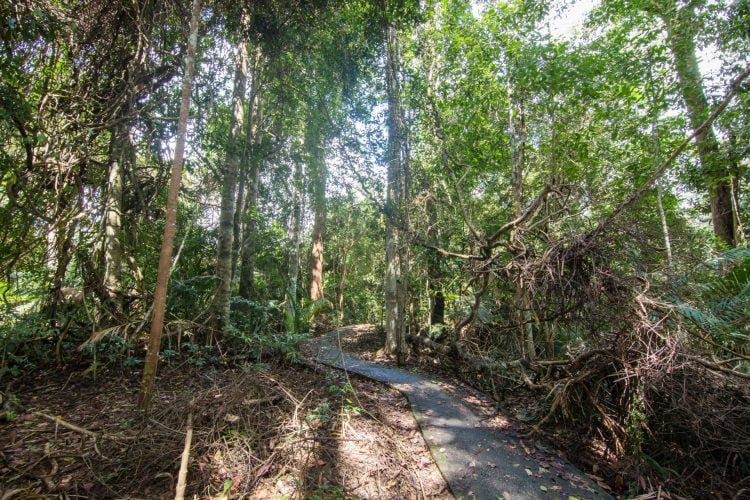
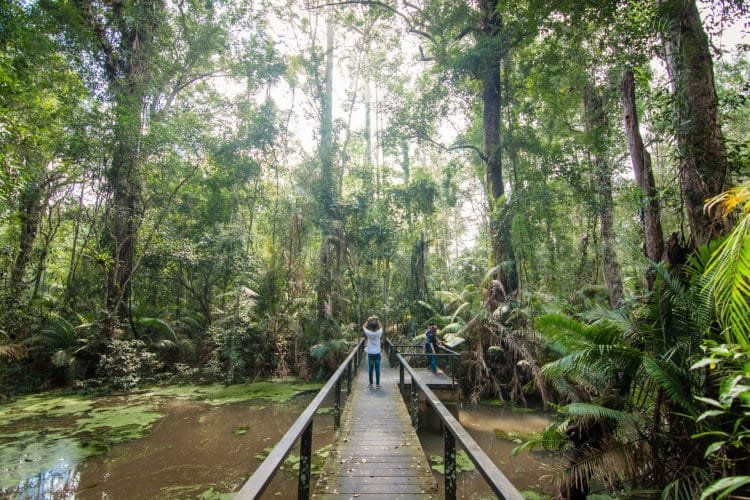
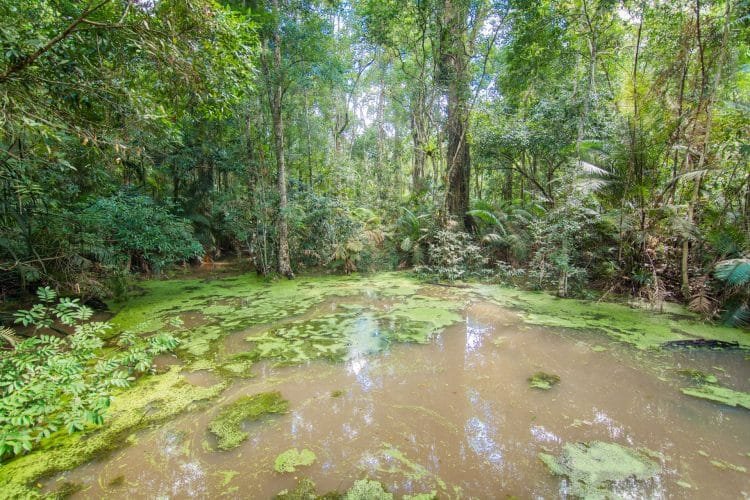
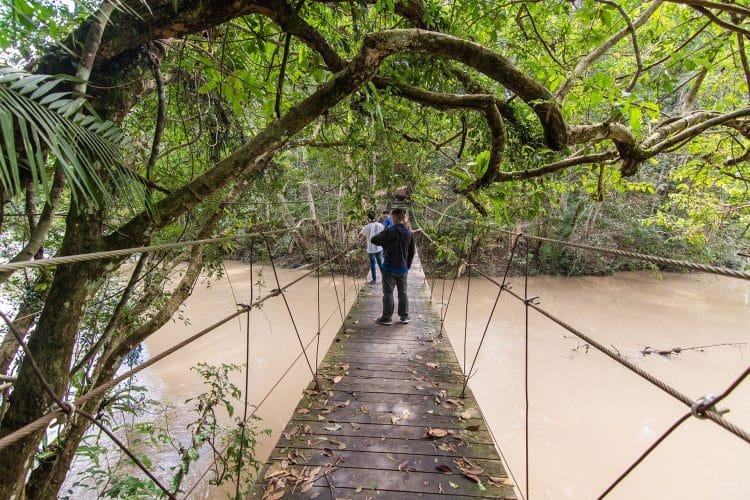
Observation areas
In addition to the Visitor Center, which is already a good spot to spot animals, you have 2 main areas, ideal for hoping to admire the local fauna. The first, you will come across it shortly before arriving at the Visitor Center if you are coming from the north (2,5 km before to be more precise).
– Nong Phak Chi Wildlife Watching Tower –
The observation tower located at the end of this small walking path is the best known in the park, as it is easily accessible from the nearby car park. Over 1 km flat, you will walk along a meadow area and reach the tower, allowing a 360° view of the area.
The tower being perched high, one can dominate the meadow, see the edge of the forest, an area with a small lake serving as a place to drink for the various animals of the park. Failing to see, one can hear birds and even gibbons in the distance.
– Mo Sing –
I call it Mo Sing because if you look on Google Maps, you will see that there would be (because I have never seen it...) an observation tower called Mo Sing just outside this open area.
Just like Nong Phak Chi, it is a cleared area on both sides of the road. You can see areas where there are salt stones that animals like to come and lick. As it is a grassland area, this leaves more chance to see a possible animal, in this case here, gaurs, gibbons venturing to the edge of the forest or even elephants if you are very lucky.
Just before Mo Sing, you'll pass the photogenic Sai Sorn water reservoir, where you're sure to spot a bunch of Thais snapping Instagram selfies.
The park's waterfalls
– Haew Suwat –
The "star" of the park, since it is at this waterfall that the famous scene of Leonardo Di Caprio jumping from the top of a waterfall was filmed while he goes in search of the famous secret beach in the film "The Beach", which greatly contributed to the recognition of Thailand as a beautiful country to visit.
The falls are located 13 km from the Visitor Center and are reached by a paved road, passing one of the park's campsites along the way.
There are 2 areas. From the car park, you have easy access to the "high" area of the waterfall, in short, you will overlook the waterfall. If you are in the middle of the rainy season, the level could be high and therefore dangerous (therefore probably not accessible).
The upper part of the waterfall has 2 different seasons:
By taking the small dirt path, you will first have a viewpoint of the falls, enough to see well with a little height, and a sufficient view if you have difficulty walking.
Because to get close to Haew Suwat, you then have to take a nice series of steps, in the shade of bamboo. Nothing really difficult, but I think of those who might have knee problems or other discomfort from very steep steps.
The waterfall seen from below has its charm, different depending on the season. It is not necessarily the prettiest in the park, but in any case the easiest to access.
Note that from this waterfall and if you are accompanied by a park guide, it is possible to reach 2 other falls along the Lam Takhong stream, Haew Sai Fai and Haew Pratoon Waterfalls. The first is only 700 m from Haeww Suwat and the second 300 m further.
– Pha Kluai Mai Waterfall –
Accessible from the campsite of the same name (Pha Kluai Mai), shortly before the Haew Suwat waterfall, it is the least interesting in the central area of the park. Already, it requires a little more effort than the others since you have to follow a 1 km dirt road, there, and therefore come back for 1 km.
If you come across elephant footprints and droppings, this is not the best place to come across them… And the waterfall itself is not really one… It is more of an area with small rapids, surrounded by forest. It is more worth it if you like nature walks and want a quiet area and you are the type to want to see everything when you visit a place (like me…).
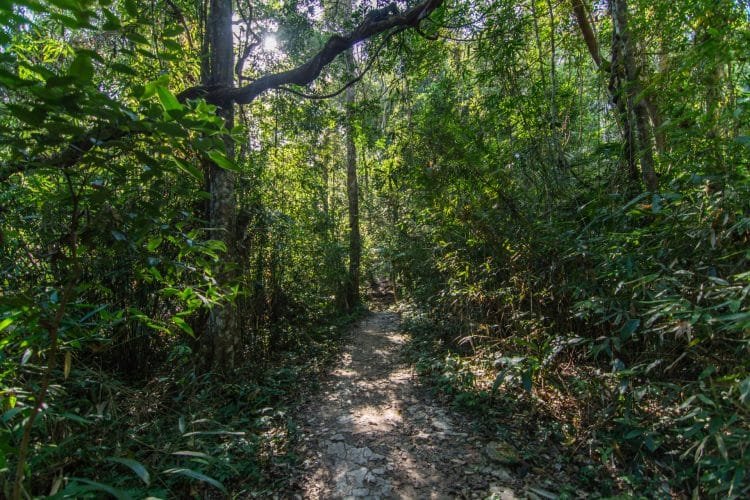
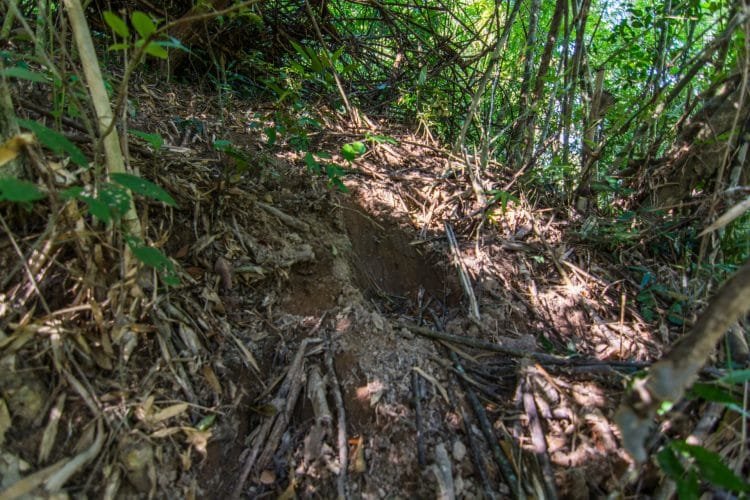
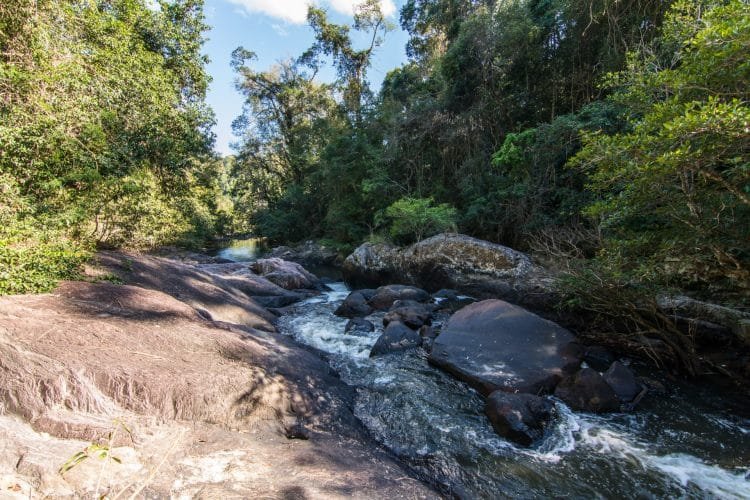
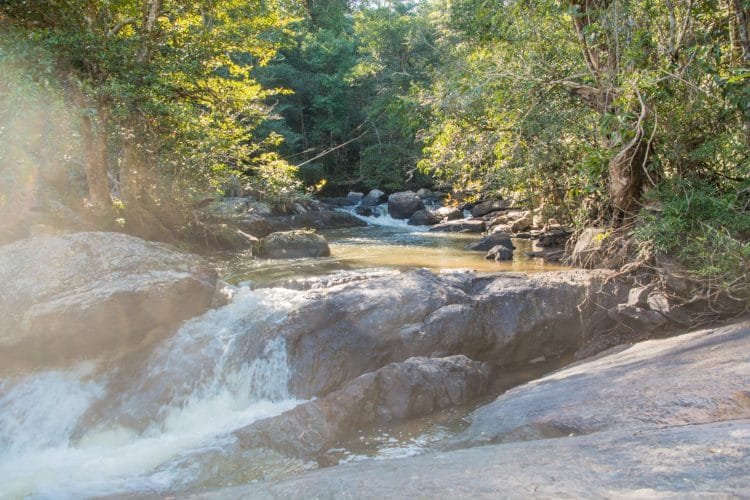

– Haew Narok Waterfall –
Probably the most impressive of all Khao Yai, it is in any case the largest with a fall totaling 150 m in height but whose main jump already reaches 80 m! Haew Narok is accessible via a 600 m path.
On the way, you will cross a bridge, under which flows the Tha Dan, source of the waterfall. You will also see some kind of large block, an anti-elephant barrier if ever there was one. It is precisely along this path that I would have the chance to see a wild elephant having a bite to eat there!
The path is very easy overall, only access to the foot of the main 80 m waterfall is a bit more risky. Already, before accessing the descent, well it goes down, so quite a few steps. Just before this final descent, you will already have a nice view of the creek and the forest surrounding Haew Narok.
There is a path of about 800 m, not marked and therefore to be avoided if you are not experienced, this path allows you to obtain a higher point of view on the falls, which end their course at the level of the lake of the Khun Dan Prakarn Chon dam.
– Wang Ta Krai and Nang Rong Waterfalls –
A logical progression in my writings, we arrive at the small falls off to the side, in the southern zone of the national park, the one which is right next to the Khun Dan Prakarn Chon dam, also called the Khlong Tha Dan dam, named after the stream feeding the lake behind the building.
2 small falls are in the area closest to the dam. More than falls, these are mainly relaxation areas for families looking for a bit of freshness on hot Thai days (i.e., a good part of the year, but in the rainy season, the water level is often too high and changing so unsafe, so it is mainly between December and April that we will see people there).
– Sarika Waterfall –
Sarika is the waterfall with some interest in this southern area of the park. However, if you have already seen all the other and main sites of Khao Yai, you will probably not have much time to devote to it, especially if you plan to visit the national park in a single day.
Viewpoints
– North viewpoint –
Just 4km after passing the northern entrance of the park, you will pass a viewpoint that you cannot miss. There you will see a car park on the left (assuming you are going down the road south) and the viewpoint on the right. The view covers part of the mountains that form Khao Yai and you will see the hotels and the northern valley at the foot of the park in the distance.
– Yod Khao Khieo Mountain –
A road leads to the top of the mountain known as Yod Khao Khieo, where the Khao Khiao control center is located. At 1292 m, it is the highest point in Nakhon Nayok province.
Before reaching the control center area, you will come across no less than 3 viewpoints. One being at the level of the cliff called "Pa Deo Die Cliff", following a well-maintained wooden plank path, you will have a partial view of the southern part of Khao Yai.
Treks and tours
To better immerse yourself in the nature of the park and have a better chance of observing the wildlife that inhabits it, hiring a guide is the only solution, mandatory to explore the trails in more depth.
For this 3 choices:
– Private tour: expect to pay between 1 Baht per person (if you are a family of 600 or more) to 8 Baht if you are alone for a day of exploration. The price for 5 people is 400 Baht (2×6 Baht. This includes the fare from/to Pak Chong, the entrance to the national park (000 Baht), a raincoat and anti-leech socks are also provided. Discover more (in English).
– Group tour: much cheaper since you can find a day of visits for 1 Baht (only 300 Baht for the half-day! And 500 Baht if you combine the two), Greenleaf Guesthouse having a good reputation for this service, in addition to offering cheap accommodation (I talk about it above).
– Night tour: If you were unlucky to see animals during the day, you can try at night, when the park is quieter. For 500 Baht per vehicle, you will be driven through some of the park’s interior forests via a night safari offered by the national park. Another chance to come across a wild elephant, deer, gibbons or otters crossing the road mischievously.
Cost: 500 B/vehicle (up to 10 people)
Reservations possible for: 19 p.m. and 20 p.m.
* Pre-book your visit at the National Park Visitor Center
To see what it's like, I can only invite you to read the article by friends Benoît and Fabienne from Novo Monde on their trek in Khao Yai (made via the GH Greenleaf which I talk about here).
Around Khao Yai Park
At the foot of the mountain or in areas further away from the central one, around roads 2090 and 3077 crossing the park, you will find some interesting places to visit. A quick overview.
Gaur point: Khao Paeng Ma
At the north-eastern corner of the park, a little out of the way since it is 60 km from the main entrance to the north of the park, you will find an area suitable for observing these large bovids, which have reappeared in this corner of the mountain following reforestation over 8 km².
Chet Sao Noi Waterfall National Park
Off the main road to Pak Chong, about 40 km from the city, lies a small lost paradise. Located in the town of Muak Mek (named after the stream that runs through it), this small national park, mainly consisting of the waterfall and a nature trail, is generally little visited by foreigners, who prefer to head straight to Khao Yai.
A favorite spot for Thai families who come to stay for the weekend, to cool off in the water and sleep on the edge and enjoy this charming green area. The waterfall, Chet Sao Noi, is similar in a certain style to those of Erawan in Kanchanaburi, smaller but also composed (hence its name) of 7 "floors".
I had the privilege the first 2 times to access it for free, before the area was "transformed" into a national park. By transform, I mean at most a few developments, paths, toilets, justifying making the place chargeable in passing...
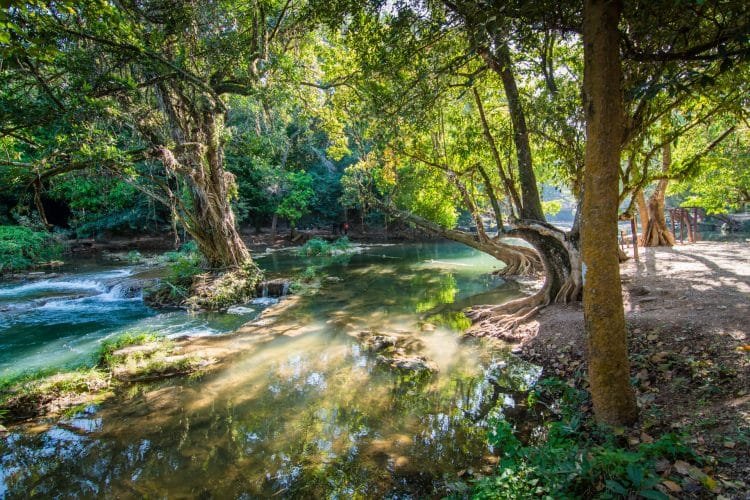
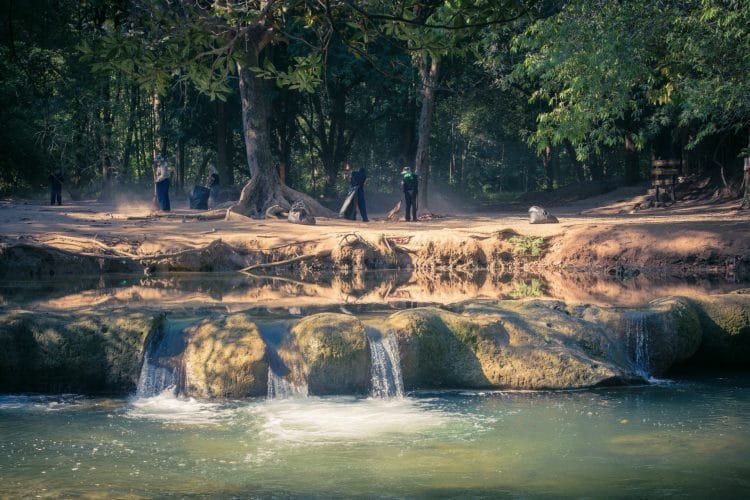

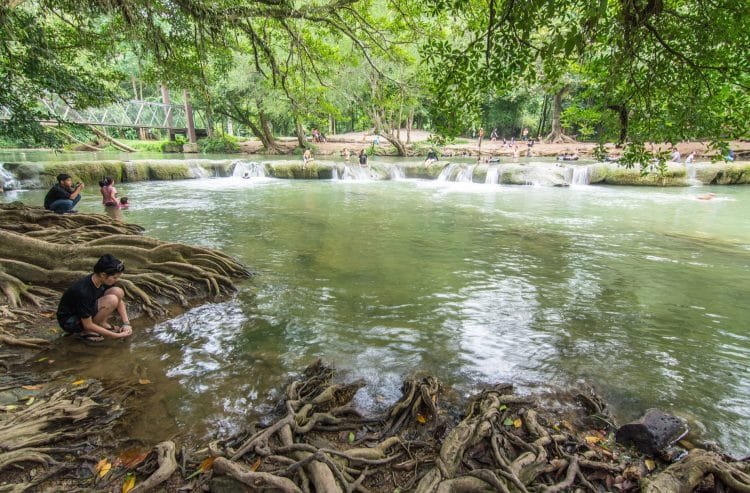
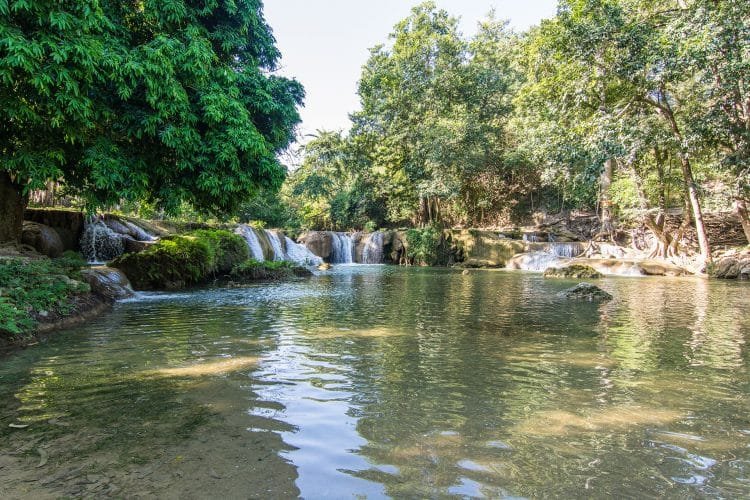
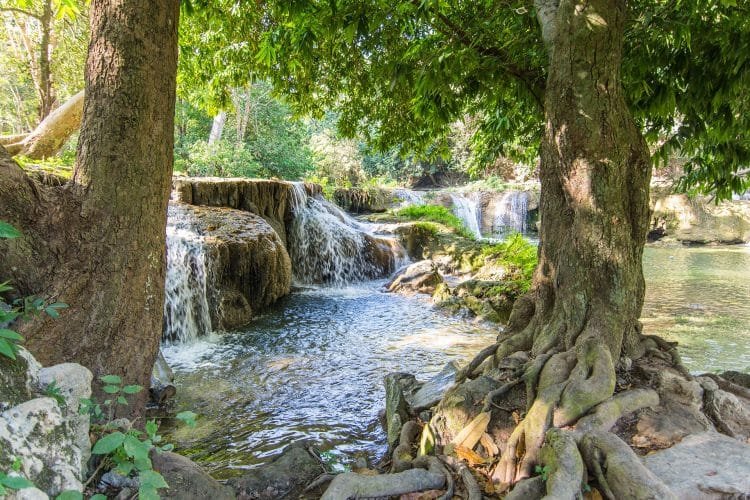
Entrance: 100 Baht per adult
Other attractions near the park – where to eat and drink?
There are many "small" attractions spread around the park, from theme parks and animal farms to reproductions of Tuscan-style villages and wine tastings - there's a bit of everything.
Among the best known, we can cite:
– Farm Chokchai, operated by a dairy manufacturer, with rodeo show and possible farm tour (Farm Tour: ฿300 for 2.5 hours).
– Ban Tha Chang Spring water, a relaxation area with your feet in the water (just 1 km away from road 2090 which goes down towards the park entrance, less than 10 km from it).
– GranMonte Vineyard and PB Wine Valley, 2 vineyards for wine lovers.
– Jim Thompson Farm, only open between November and February (usually late January even), when many flowers and plants are visible, from giant pumpkins to fields of sunflowers (Entrance: ฿180, including a walk around the farm)

Jim Thompson Farm (photo credit: Charin Ninsu CC BY 3.0 License)
Then we can mention 3 commercial and hotel areas on the theme of Italy (I don't know who thought that Khao Yai = a touch of Tuscany...)
- Tuscany Valley, composed in particular of the renowned La Casetta Hotel, we must admit that the setting is idyllic and photogenic.
– Palio Village, built like a sort of small Italian village, with its village square and fountain and brightly colored buildings, it is the only one I came to because it is located along the main road 2090 leading to the northern entrance of the park (so hard to miss).
– Primo Piazzo, a theme park popular with families who come to feed alpacas (relation with Italy??) – entrance ฿200
Finally, I can mention the multitude of themed restaurants and cafes such as:
– Thames Valley, themed around old London England, for sleeping, dining or enjoying tea
– the Castle at Midwinter Green, in the same vein, for a chic dinner
– the photogenic Yellow Submarine Coffee Tank, with its unique design
– the Secret Art Garden, for artists
– the Ban Mai Chay Nam restaurant with its resolutely retro (and somewhat mishmash) style
– the Chocolate Factory if you are a chocolate fan and easily fall for a little dessert
Finally, I won't name names, but if you like golf, there are no less than 5 courses and clubs in the northern area of the park alone. This is also where all the attractions mentioned are concentrated. Hence the greater popularity of Pak Chong as a base, rather than Nakhon Nayok, to the south, which lacks appeal.
But if you skip the frills and focus mainly on visiting the park itself, Nakhon Nayok will be more laid back and could very well suit you.
Did you like the article? share on Pinterest!
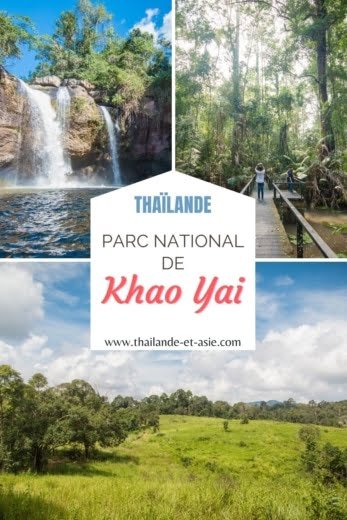


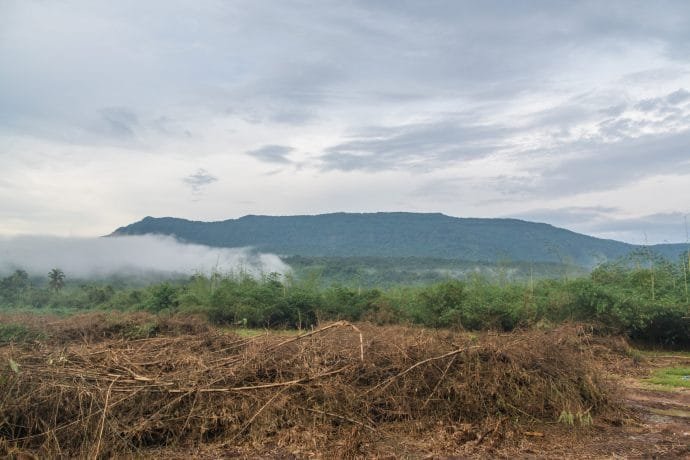
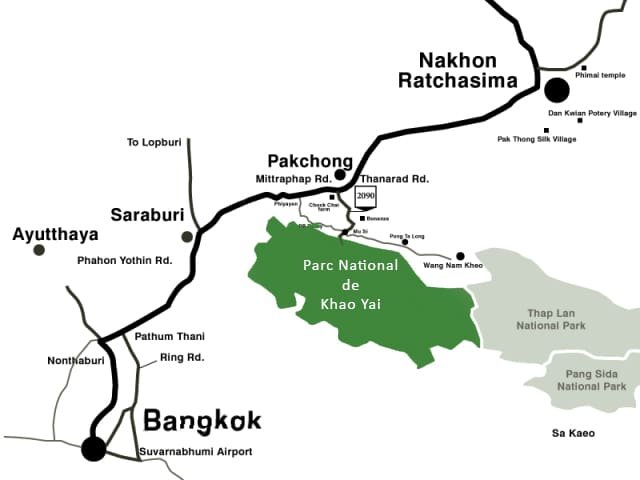

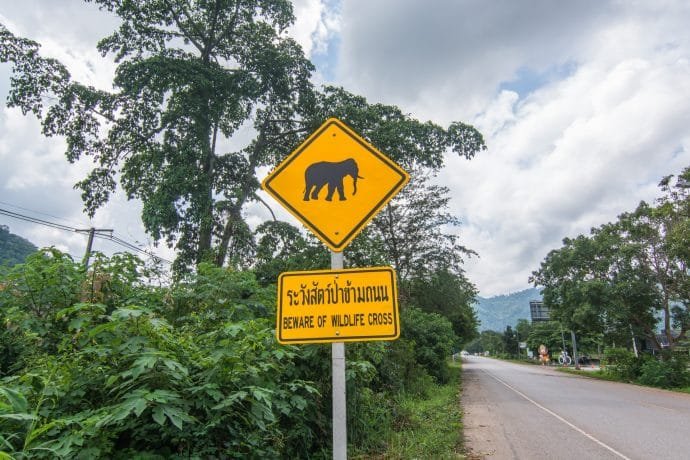
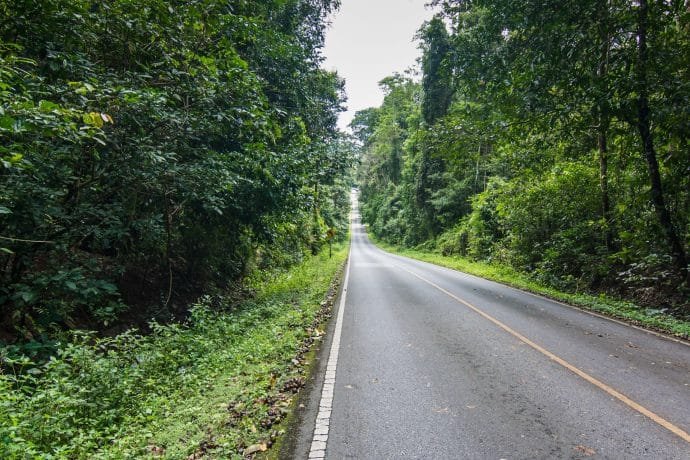
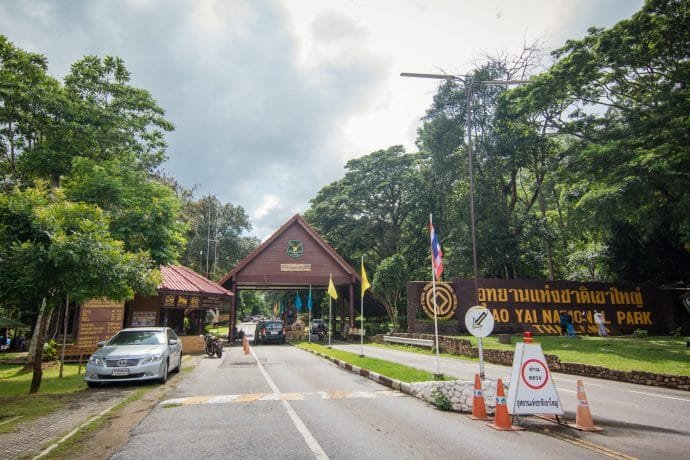
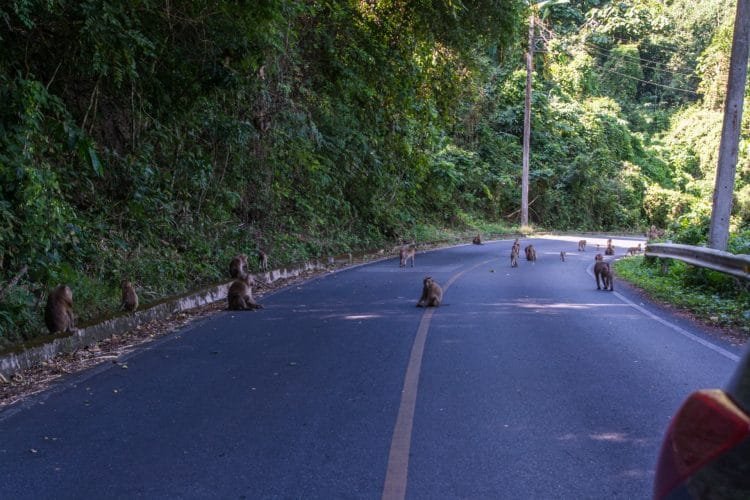
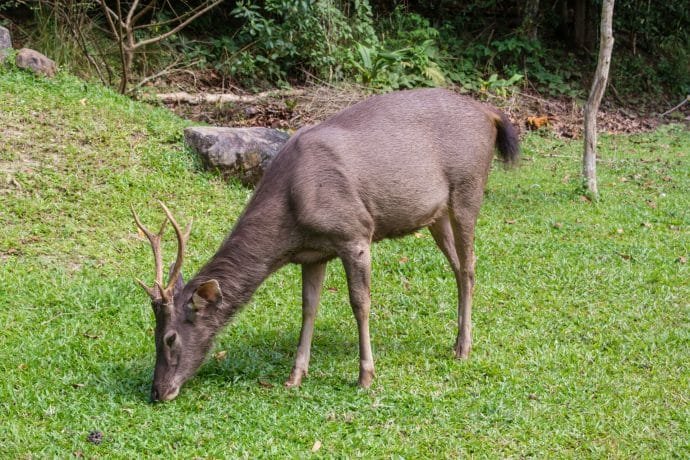
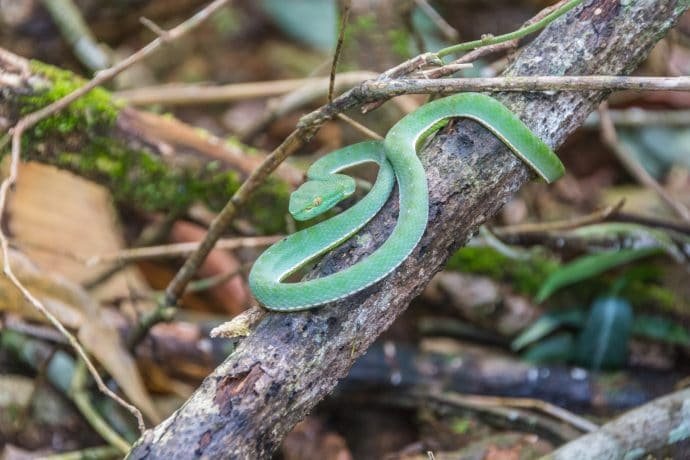

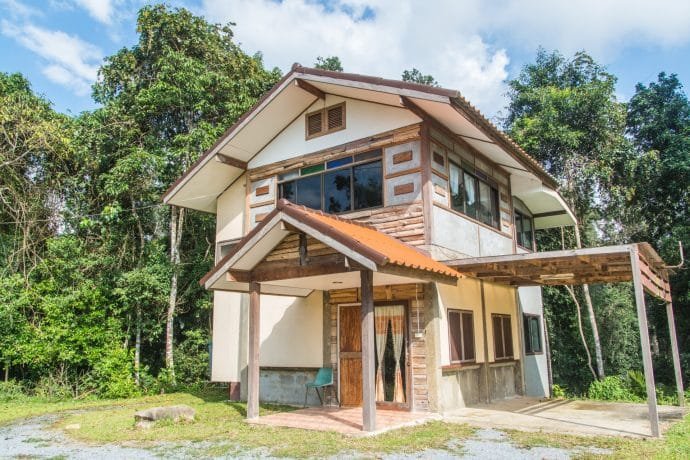
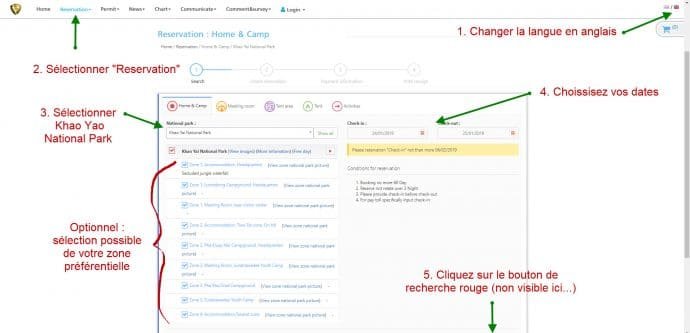
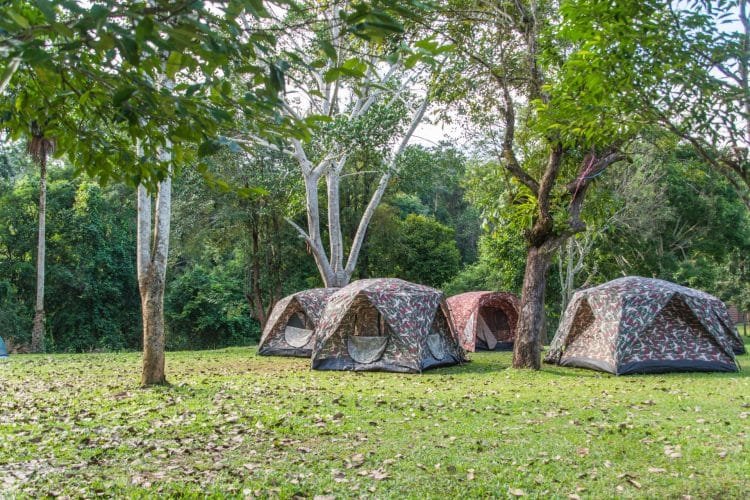
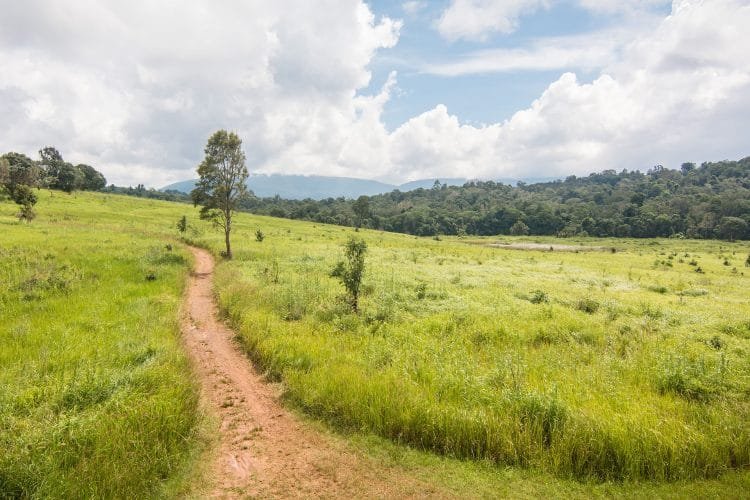
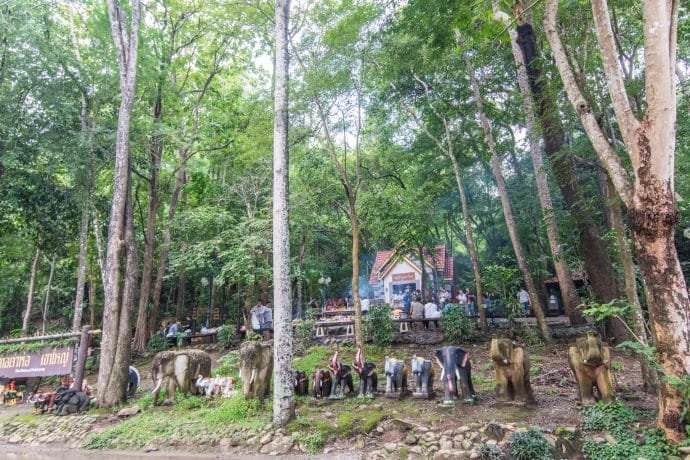
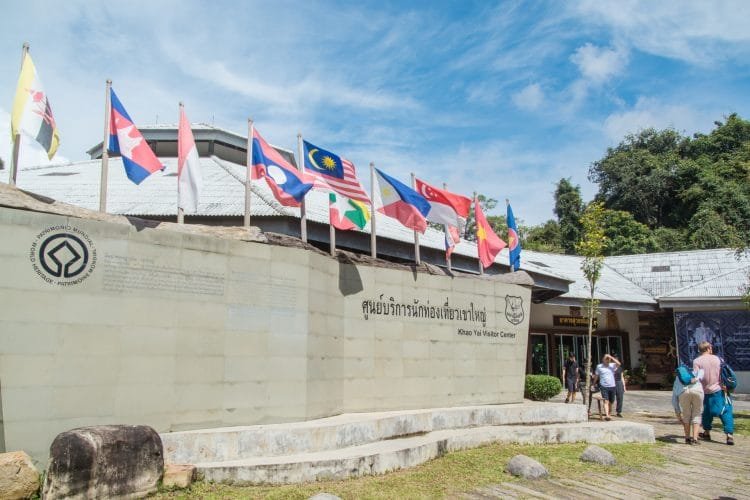

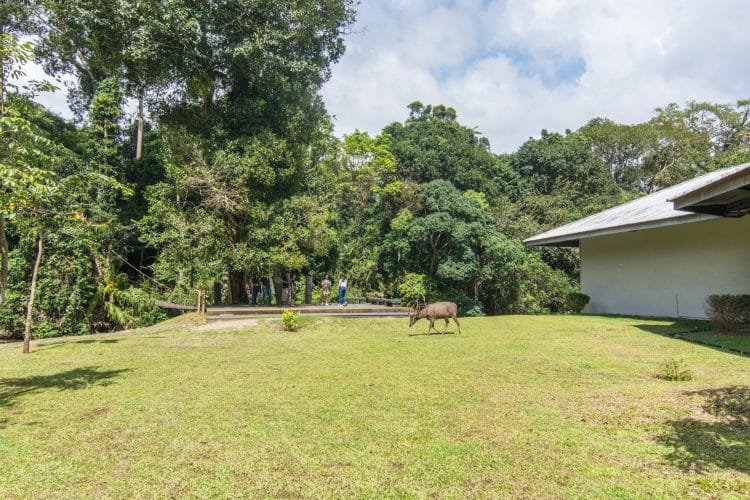
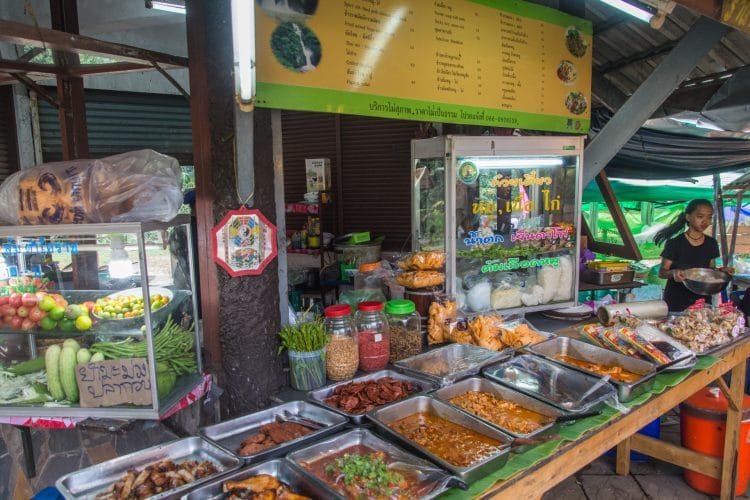

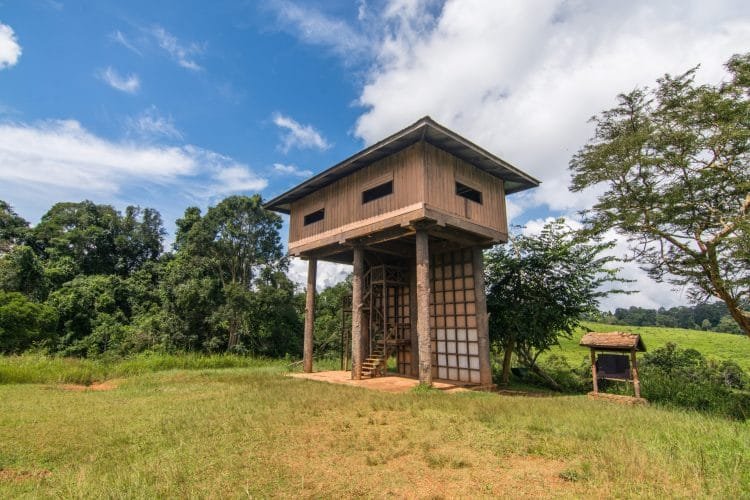
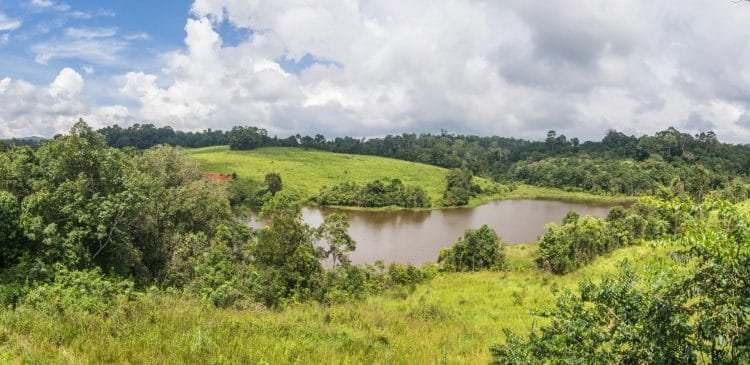
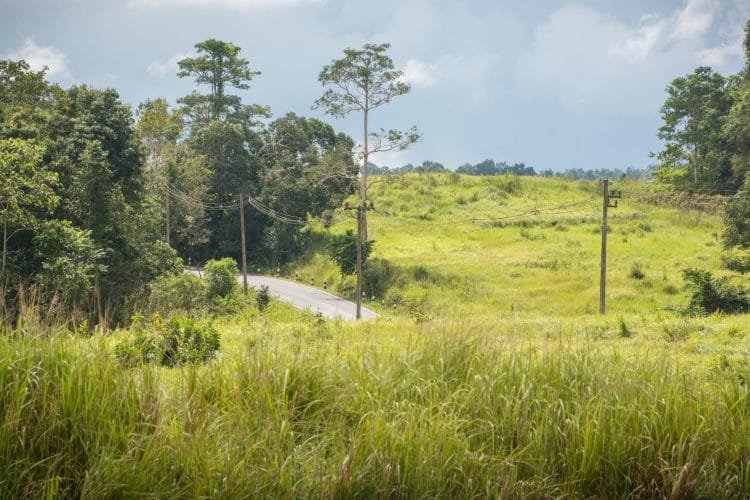

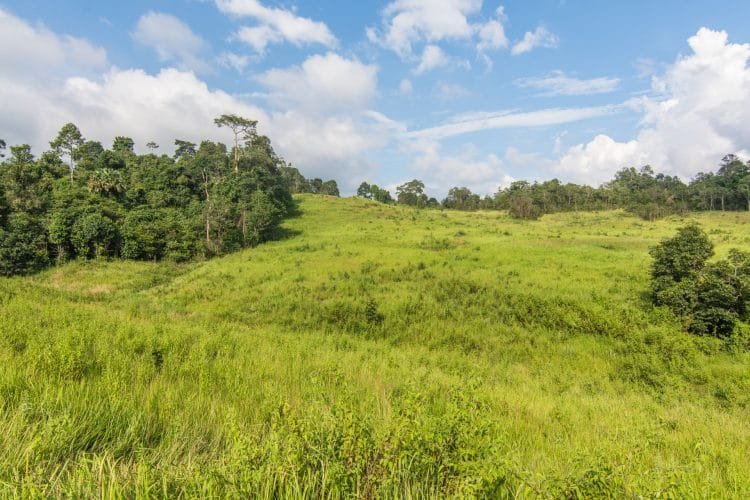
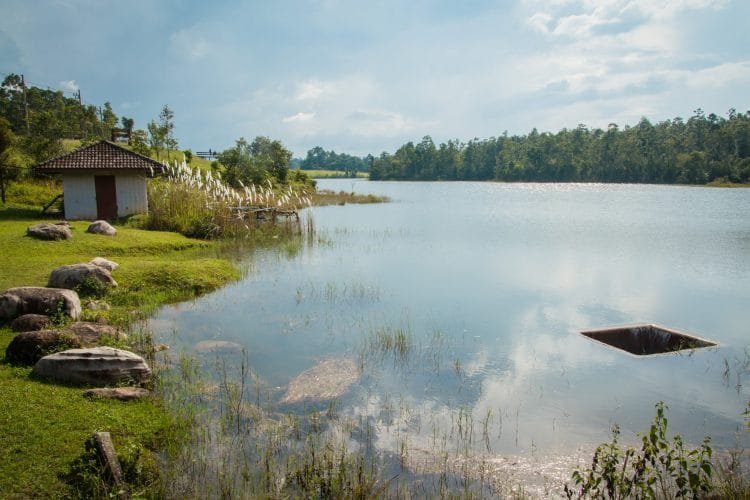
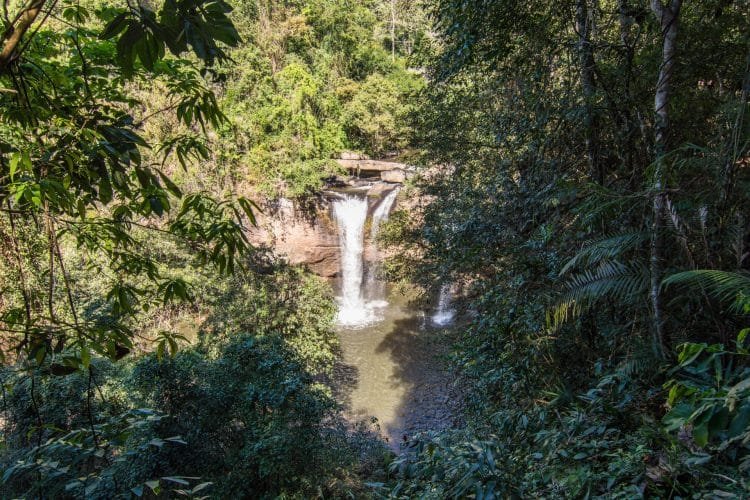

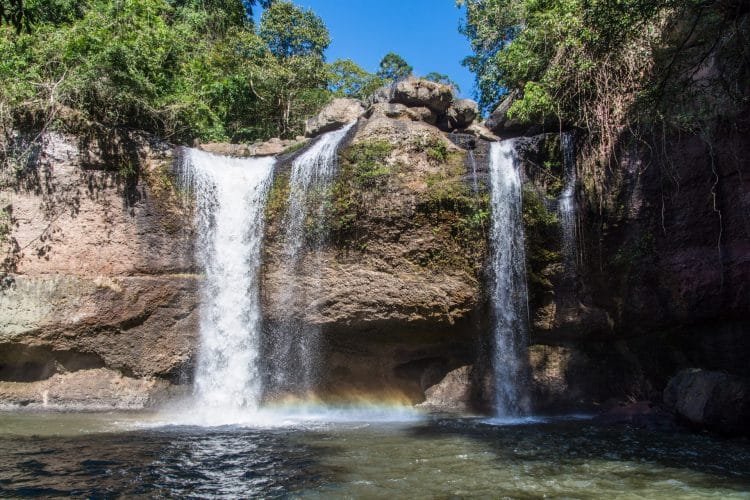
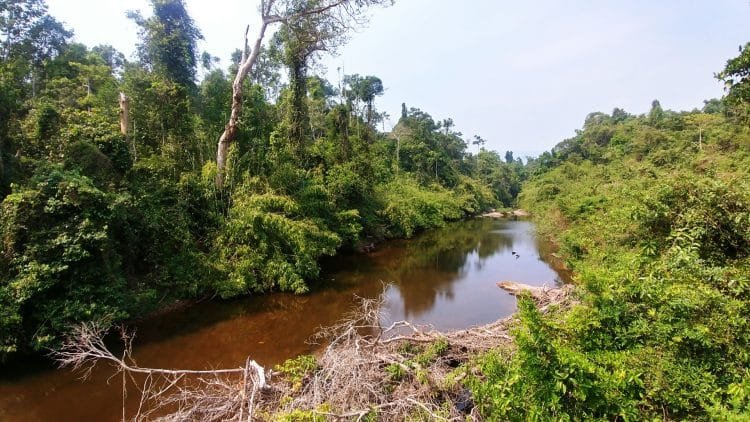
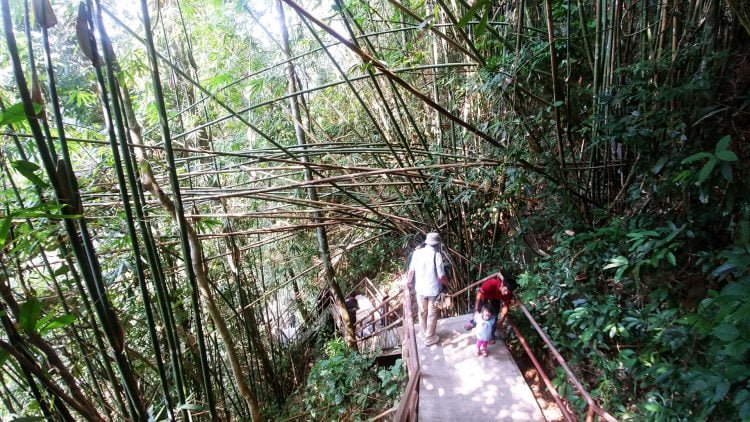
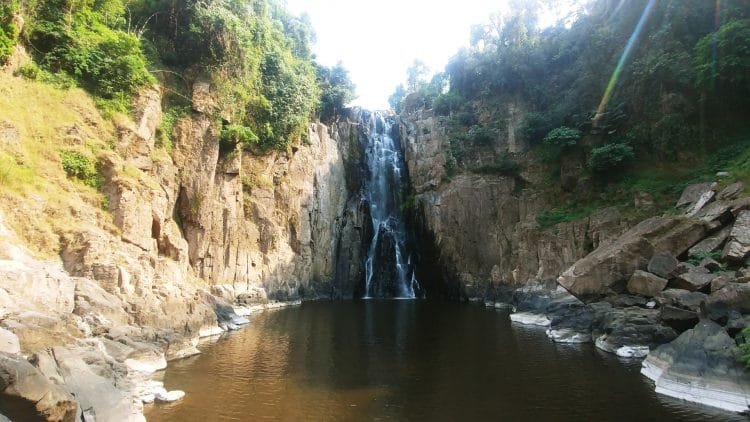
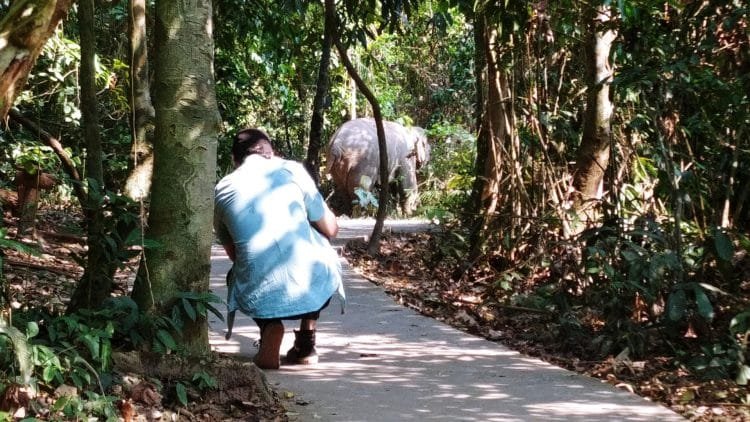
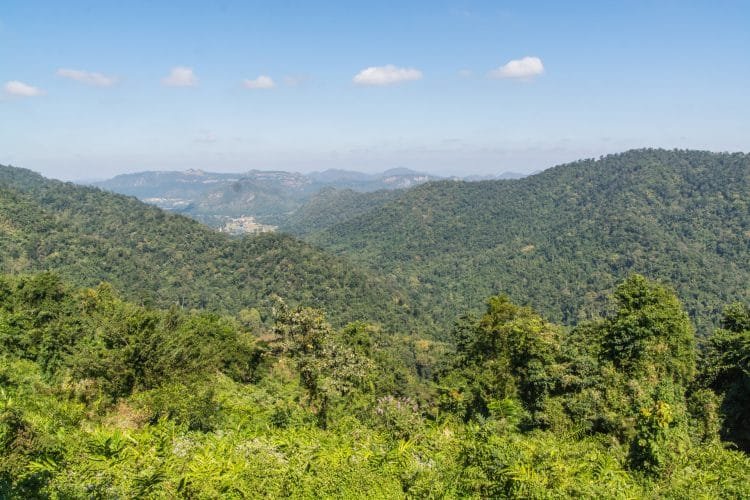
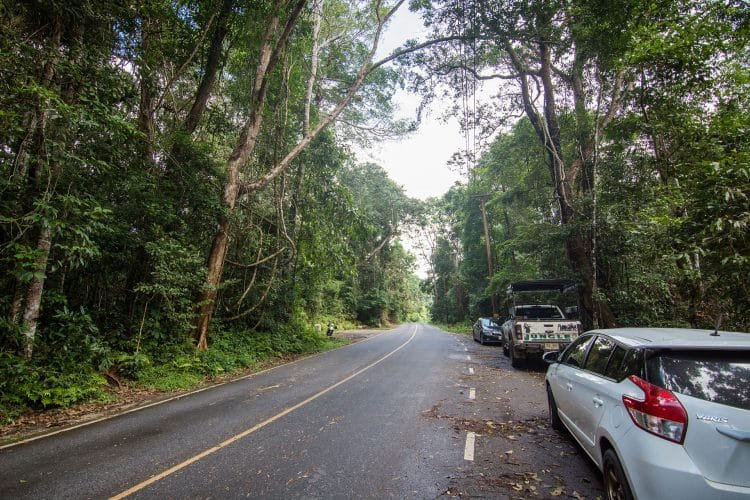
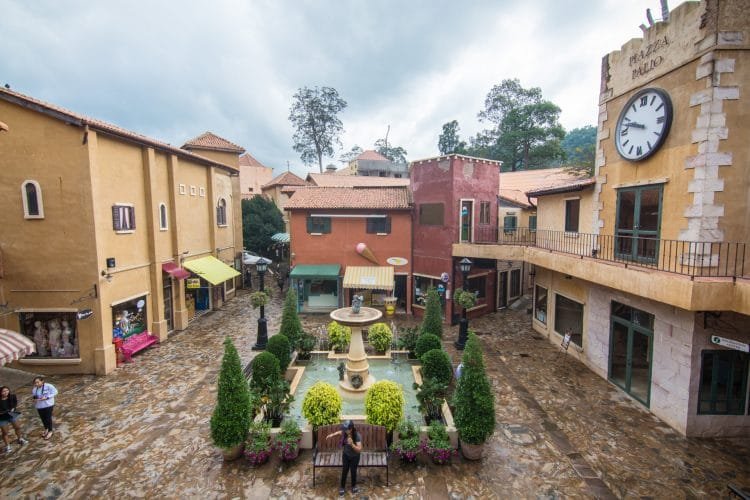
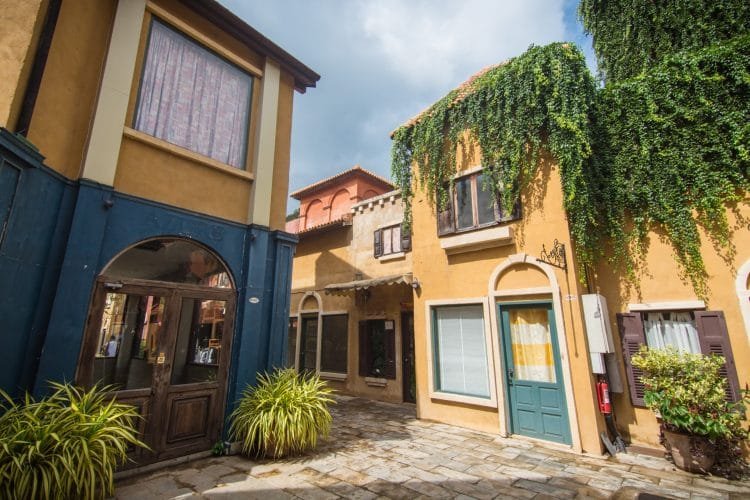


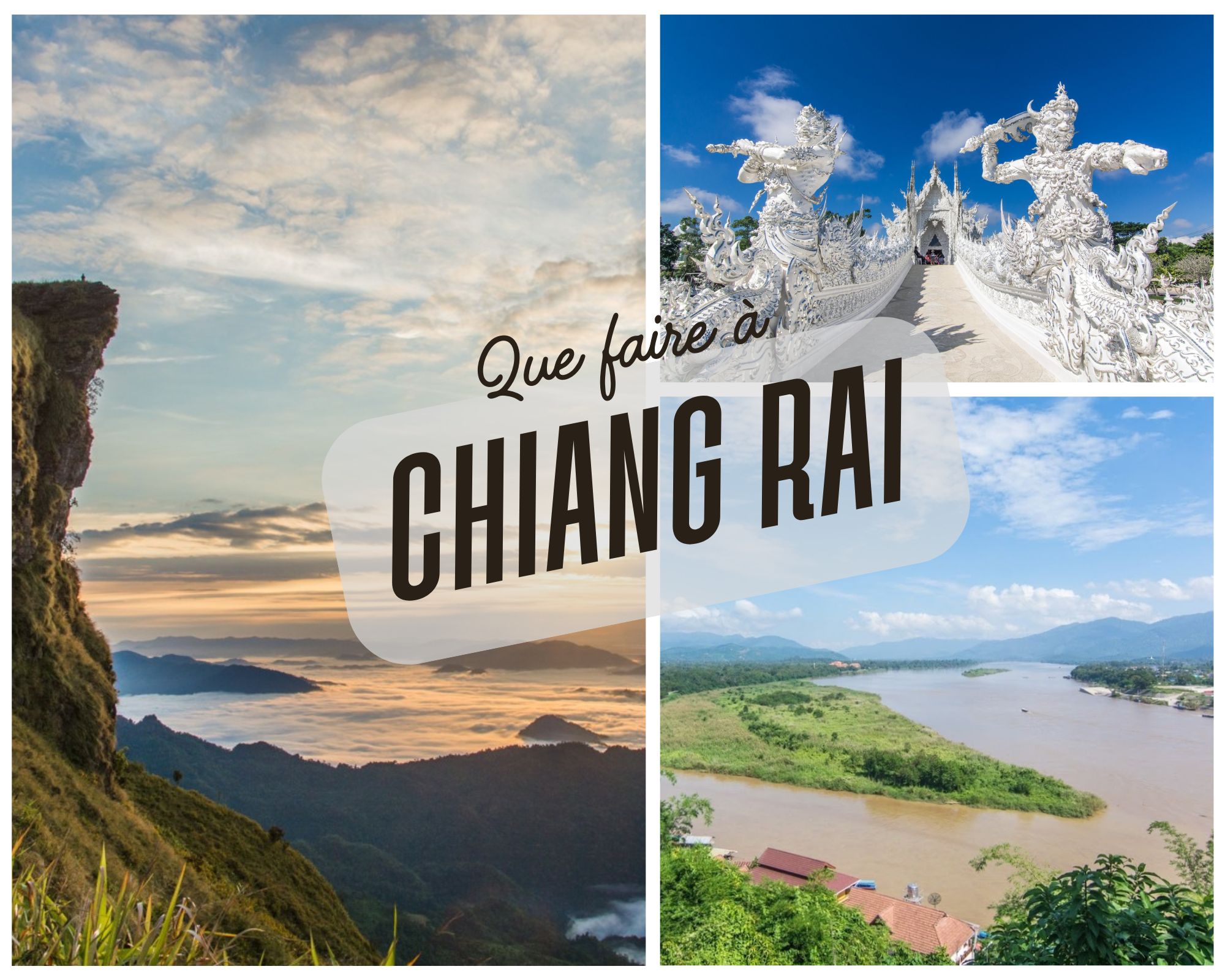



Claire Thouilly
Hello,
First of all, thank you and congratulations for your blog, the photos are magnificent and the articles are a mine of information.
In your article on Kaoh Yai, you advise having a vehicle (car rental), this is really what we would consider for our week between Khao Yai, Phimai, Phanom Rung and why not CHET SAO NOI WATERFALL NATIONAL PARK, (which I had not heard of before… 🙂 Renting a car is our way of traveling. We have already driven in Mexico, Canada, Europe obviously… but never in Asia. BUT in view of the advice to travelers in Thailand, the car option scares us, what about in this part of the country?
Roman
Hello,
Thank you for your comment. In fact the problem is not renting a car, the advice is more for those who want to rent 2 wheels, the most exposed to accidents. Overall you have to be vigilant and get used to driving on the left but it is not that chaotic. Traffic in the countryside remains largely affordable so go for it 😉
Claire
Great! Thank you!!! I am relieved because traveling like this is so much easier and suits us much better!! 🙂
Groc
Hello, great article full of information.
For our 6th Honda CBX 500 motorcycle road trip in Thailand, we will leave from Bangkok towards the south of LAOS
My question is: can we cross the park by road 3077, to avoid part of the national roads?
Thank you
Roman
Hello,
Absolutely, Route 3077 is open to traffic and joins Route 2090 on the north side of the park. Enjoy your trip!
Carole
Hello,
Thanks for all the info,
I can't reach greenleaf guesthouse!
we are going to take accommodation in Pak Chong, do you think we can find a guide in the city who can take us for a day to enjoy discovering the park, to see some animals,?
Thanks for your feedback.
Roman
Hello,
Knowing that it is the main city to access the national park, I would say yes, there should be something to find there but I wouldn't necessarily know where. Without necessarily sleeping there, it is still possible to go and see on site at Greenleaf since they organize outings.
lucie
Hello
Your blog is very useful for my future trip in March. I am a single woman, and Khao Yai makes me dream. I want to do it over 2 days and sleep in the park if possible in a bungalow. But I can't find a link to book, if you have any leads...
I also looked at the site that offers excursions for single people, but the prices are very high! If I go to the visitor center by myself, can I find a cheaper guide for the 2 days?
Thank you in advance for your response!
Roman
Hello,
You can only book via the official website of the organization managing the national parks (Department of National Park or DNP). You must select the park and the area where you want to sleep (there are several) on this link: http://nps.dnp.go.th//reservation.php?option=home
However, to do this, you have to be independent, because it is impossible to go to the park without an excursion since you will not have public transport. However, with an excursion, accommodation will be included anyway if you go for two days. I do not know to what extent it is possible to use transport for the day via the reception, not at the visitor center (which is inside the park) but at the north entrance gate, sleep there and arrange for the same transport to pick you up the next day and finish the visits...
For the prices, if you look here, it's 1800 Bahts for a day and a half, which doesn't seem excessive to me: http://greenleaftour.com/tours.html